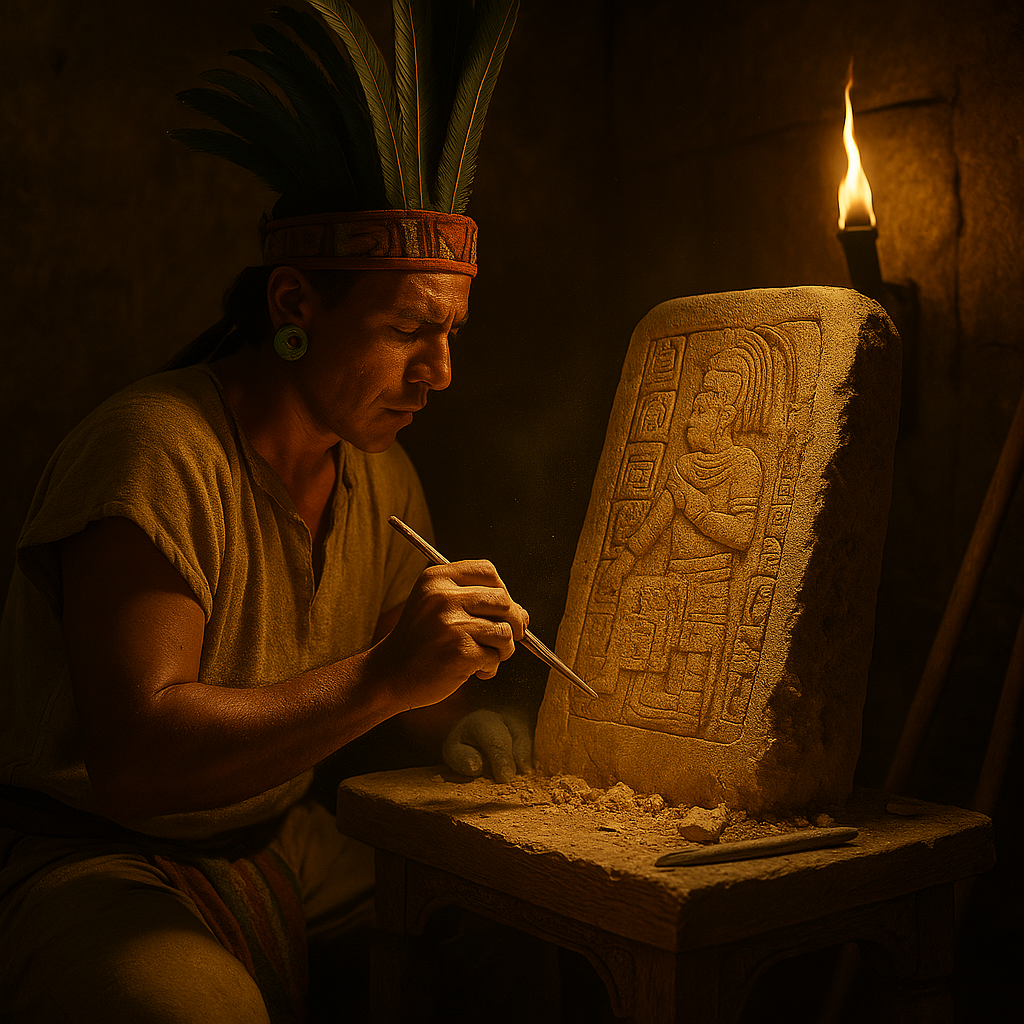On July 8 in the year 292, beneath the dense canopy of the Petén rainforest, the ancient Maya city of Tikal witnessed a moment that would echo through millennia. Stela 29 was erected to commemorate the enthronement of Siyaj Chan K’awiil I, marking not only a royal accession but a cultural milestone in Mesoamerican history. Carved from limestone and painted in vivid pigments, the stela stood as both a political statement and a testament to the intricacies of Maya cosmology, glyphic writing, and architectural grandeur.
This blog embarks on a deep journey into that distant past, unraveling the rich tapestry of Maya society, the significance of Stela 29, and the processes by which modern archaeology has illuminated this ancient event. Along the way, we’ll draw out lessons that resonate with our own lives today—how small symbols and deliberate actions can cement a personal legacy, kindle community bonds, and spark creative expression. By exploring specific strategies rooted in the ancient Maya’s approach to ritual, record-keeping, and leadership, you’ll discover a tailored plan to inscribe your own story into the world around you.
—
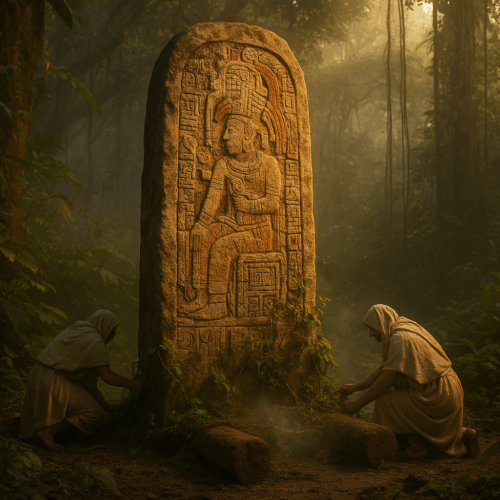 The Grandeur of Tikal in the Late Classic Era
The Grandeur of Tikal in the Late Classic Era
Perched atop limestone ridges, Tikal’s skyline once bristled with pyramids, palaces, and stelae reaching skyward. By the late 3rd century, Tikal had blossomed into a political powerhouse within the central Maya lowlands. The city’s rulers wielded influence through strategic alliances, trade in jade and obsidian, and by marshaling labor for monumental architecture. Large plazas pulsed with ritual activity—bloodletting ceremonies, ballgames, and astronomical observations tied to the sacred calendar.
Stela 29, rising nearly three meters high, was more than a mere stone slab. Its front face presented the new king, Siyaj Chan K’awiil I, seated on a throne adorned with jaguar motifs and flanked by the feathered serpent, emblem of rulership and divine connection. Above his figure, glyphs recorded the exact Long Count date: 8.17.0.0.0.0 (July 8, 292), embedding the event into the cosmic cycles that governed Maya belief. When the stela was first painted in reds, ochres, and blacks, it shone like a beacon, signaling a new chapter in Tikal’s dynastic saga.
In the broader geopolitical landscape, rival cities such as Calakmul and Caracol watched Tikal’s ascendancy with keen interest. The Maya world was a patchwork of competing dynasties, each seeking advantage through warfare, marriage alliances, and ritual exchange. Records on neighboring stelae show that tensions sometimes erupted into open conflict—raiding parties would burn enemy monuments, communities would take captives, and elaborate marriage contracts would realign power blocs. Within this crucible of ambition, Tikal’s decision to celebrate Siyaj Chan K’awiil I with such lavish public display was both cultural affirmation and strategic deterrent.
Before July 8, 292, Tikal’s royal lineage traced back centuries, but Siyaj Chan K’awiil I would become a touchstone for future monarchs. His name—“Born of the Sky”—underscored a claim to divine origin, a theme deeply woven into Maya rulership. Every subsequent Tikal king would associate himself with celestial phenomena—eclipses, solstices, Venus cycles—to legitimize their authority. Siyaj Chan K’awiil’s enthronement was thus a foundational myth, a template for how the Maya understood rulership as part of the cosmic order.
—
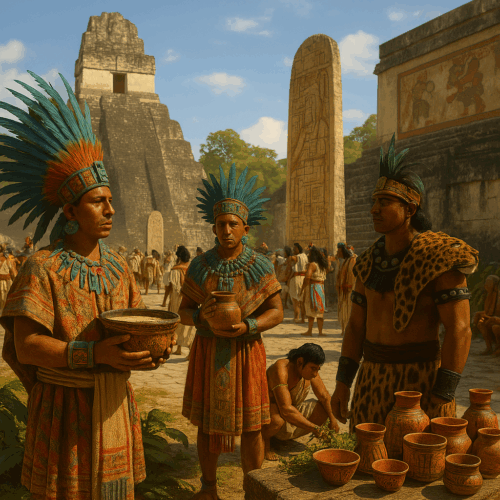 Carving History: The Making and Meaning of Stela 29
Carving History: The Making and Meaning of Stela 29
The creation of Stela 29 began with quarrying massive limestone blocks from nearby hills—a laborious process involving hundreds of workers hauling stone on wooden rollers. Once at the city core, sculptors painstakingly shaped the stela’s surface with chert and obsidian tools, etching intricate glyphs that combined logograms and syllabic signs. Artists applied a stucco coating, smoothing ridges before inscribing final lines, then painted the glyphs with organic pigments derived from plants and minerals.
When Siyaj Chan K’awiil’s image appeared, seated and dignified, the likeness was idealized. The king wears a towering headdress of quetzal plumes and jade, his chin adorned with the ceremonial “Jade Labret” signifying royal blood. Under his throne, the glyph for “snake” curls, connecting him to the giant serpent god Kukulkán. Surrounding the main panel, smaller glyph blocks enumerate his parentage, titles, and the auspicious rituals—fire ceremonies, feasts, and blood offerings—performed to usher in his rule. Each element reinforced the narrative: this was no ordinary man, but a divinely sanctioned ruler whose lineage and deeds were inscribed in stone for eternity.
Beyond its political function, Stela 29 served a calendrical purpose. Maya scribes and astronomers used such monuments to anchor cycles of 260-day sacred tzolk’in and 365-day solar haab calendars, as well as the Long Count—an uninterrupted count of days from a mythic starting point in 3114 BC. By marking Siyaj Chan K’awiil’s accession at a precise zero-ending Long Count date, Tikal’s chroniclers linked their king’s rule to cosmic renewal. Every 52-year Calendar Round cycle, the stela’s anniversary would be ritually observed, reaffirming the ruler’s bond with the celestial realm.
Interestingly, Stela 29 bears evidence of later re-painting and re-engraving during the Late Classic period. Archaeologists found pigment residues indicating at least two cycles of renovation, suggesting that Tikal’s later rulers revered Siyaj Chan K’awiil’s legacy and sought to maintain the stela’s vibrancy. This practice underscores how deeply the Maya connected material preservation with spiritual continuity—they believed that renewing a monument’s appearance breathed new life into its symbolic potency.
—
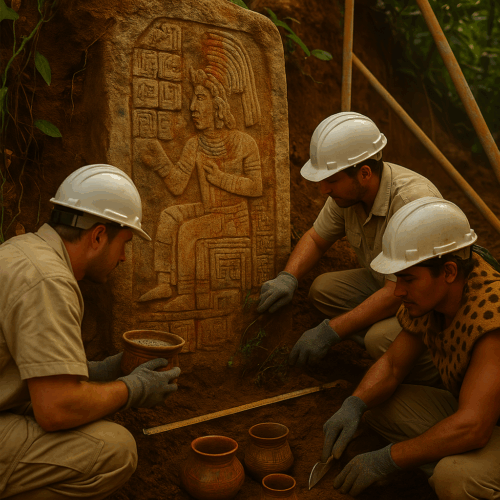 Tikal’s Sociopolitical Networks and the Wider Maya World
Tikal’s Sociopolitical Networks and the Wider Maya World
Stela 29 did not stand in isolation. Nearby monuments—Stela 31, erected in later centuries—refer back to Siyaj Chan K’awiil’s achievements, citing victories over rival polities and triumphant passages through sacred caves. Through these interconnected records, historians can reconstruct Tikal’s alliances and feuds. For example, inscriptions hint at a marriage alliance between Tikal and the elite house of Teotihuacan in central Mexico, reflecting long-distance diplomacy that brought new ritual forms and material wealth to the lowlands.
Trade routes radiated from Tikal, linking salt producers on the Yucatán coast, obsidian quarries in the highlands, and cacao growers in the Petén marshes. Tikal’s rulers controlled key roads, exacting tribute in trade goods and captives. These economic networks financed monumental building projects and sustained a class of scribes, artists, and priests who filled the city’s plazas with cosmological performances. The hierarchical structure of Maya society—ruler, nobles, scribes, artisans, farmers, and laborers—enabled large-scale cooperation, but also generated tensions that occasionally erupted into palace coups or city-state wars.
Ritual warfare, far from chaotic, operated within strict ceremonial boundaries. Stelae record “star wars”—attacks timed to Venus’s appearance as the morning star—when the planet’s alignment was believed to favor conquest. Victorious cities would dedicate captured warriors in public sacrifices, reinforcing the victor’s sacred mandate. Siyaj Chan K’awiil’s own inscriptions, though focused on accession rites, later allude to military triumphs, hinting that his reign combined piety with pragmatic defense of Tikal’s influence.
Interpreting these dynamics reveals a sophisticated political philosophy: rulership required balancing divine favor, military prowess, and economic stewardship. Monuments like Stela 29 projected an image of timeless authority, but under the surface, Tikal’s dynasty navigated shifting alliances, resource competition, and ritual obligations. The Maya understood power as a living contract between ruler, community, and cosmos—a framework that held societies together for centuries.
Reconstructing the Past: Archaeology Meets Epigraphy
The story of Stela 29’s modern rediscovery began in the 1950s, when the University of Pennsylvania’s archaeological expeditions systematically mapped Tikal’s ruins. Jungle vines and centuries of debris had buried many monuments, leaving only fragments protruding from the earth. With meticulous stratigraphic excavation, teams uncovered the stela’s base first, later revealing its full height. Photogrammetry documented each glyph, while conservationists stabilized the carved surfaces to prevent further erosion.
Epigraphers then translated the hieroglyphs, a process that accelerated with breakthroughs in Maya decipherment during the 1970s and 1980s. By comparing glyph forms across dozens of sites, scholars cracked phonetic signs and calendar notations, turning enigmatic shapes into readable history. The reading of 8.17.0.0.0.0 as July 8, 292 was confirmed by matching lunar and Venus tables inscribed on other monuments.
Advances in aerial LiDAR technology have since revolutionized our understanding of Tikal’s urban sprawl. Hidden reservoirs, causeways, and agricultural terraces emerged in digital terrain models, revealing that Tikal supported tens of thousands of inhabitants—far beyond what earlier surface surveys estimated. Stela 29 now stands amid reconstructed plazas that pulse with the energy of a vibrant city, not merely isolated ruins.
These scientific methods transform silent stone into living narrative. Each flaked glyph holds clues about artisans’ tools, political events, even climatic conditions—wind-blown sediment layers suggest droughts that may have prompted shifts in Tikal’s water management. When modern researchers piece together these fragments, they weave an immersive story of human adaptation, ingenuity, and ritual expression across centuries.
—
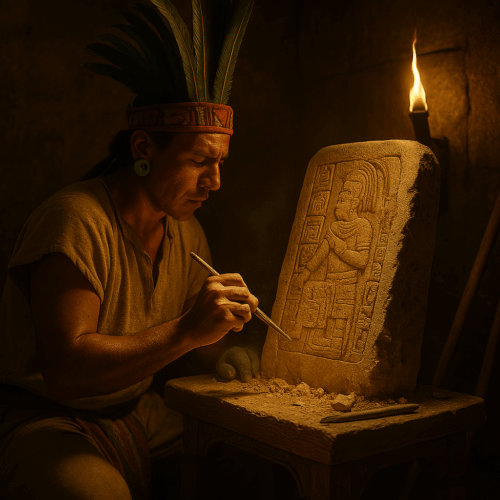 Maya Writing, Calendars, and the Memory of Kings
Maya Writing, Calendars, and the Memory of Kings
Maya hieroglyphs represent one of the New World’s most sophisticated writing systems. Combining logographic and syllabic elements, the script captured names, events, dates, and devotional texts. Nobles hired scribes to record births, deaths, wars, and alliances, ensuring that every notable action was lodged in communal memory. Monumental stelae, codices (folded bark-paper books), and painted murals formed an integrated communication network binding far-flung cities.
Calendrical science underpinned this system. The Long Count provided a linear accounting of days, while the sacred tzolk’in and solar haab governed daily rituals and agricultural cycles. By inscribing a Long Count date on a stela, Maya elites anchored personal biographies within cosmic rhythms. Siyaj Chan K’awiil’s enthronement on a zero-ending tally had powerful resonance: it signified completion, fresh beginnings, and alignment with universal order.
For today’s individual, the Maya approach to time and memory holds surprising relevance. They crafted shared narratives—stela by stela, mural by mural—that united communities around common origins and values. They treated writing not merely as record-keeping but as active ritual, investing words with sacred force. Their calendars encouraged cyclical reflection: every 52 years, a Society-wide renewal ceremony reaffirmed social bonds.
Imagine applying these principles to personal growth. What if you marked your own milestones—career changes, creative projects, life events—with symbolic artifacts, deliberate ceremonies, and written narratives? What if you mapped your progress onto recurring themes, revisiting each “cycle” with renewed intention? The Maya show that when society shares stories of achievement, it fosters cohesion and a sense of destiny far greater than isolated effort.
From Stone to Self: A Plan for Modern Legacy Building
Drawing inspiration from Siyaj Chan K’awiil’s stela and the Maya worldview, here are specific steps to forge your own lasting legacy:
- Define Your Foundational Date
Choose one personal cornerstone—an entrepreneurial launch, educational milestone, or creative debut. Mark it in writing, identifying symbolic attributes (colors, imagery, phrases) that capture its essence. - Create Your Personal Stele
Commission or craft a physical or digital “monument” (a sculpture, painting, commemorative video, or dedicated webpage) that features your central narrative—your “enthronement” moment. Incorporate symbols meaningful to you: a family crest, a motif from your field, or a personal motto. - Calendarize Your Cycles
Establish two interlocking cycles: a sacred cycle (e.g., quarterly reflections) and a solar cycle (annual reviews). At each cycle’s culmination, host a ritual—invite mentors for a small dinner, share achievements in a community newsletter, or hold a personal ceremony with music and journaling. - Inscribe Your Story
Maintain a living journal that blends log entries (events, data points) with reflective prose. Use dates consistently, referencing both civil and symbolic calendars (for instance, “Day 104 of Cycle 3”). Over time, patterns will emerge—your “glyphs” indicating strengths, challenges, and growth nodes. - Engage Your Network
Share excerpts of your journey via social media, blog posts, or local talks. Encourage peers to create parallel monuments, fostering a networked community analogous to Maya city-states exchanging stelae. Collective storytelling amplifies individual achievements. - Renew and Repaint
Every few years, revisit your “stele.” Update texts, refresh visuals, and celebrate anniversaries. This renewal mirrors the Maya practice of repainting monuments, ensuring your legacy remains vivid and relevant. - Align with Cosmic Rhythms
Incorporate natural cycles: plan vision workshops on the solstices, set creative marathons during new moons, and pause for rest during eclipses or equinoxes. By syncing personal rituals with universal rhythms, you cultivate deeper resonance and sustained motivation.
—
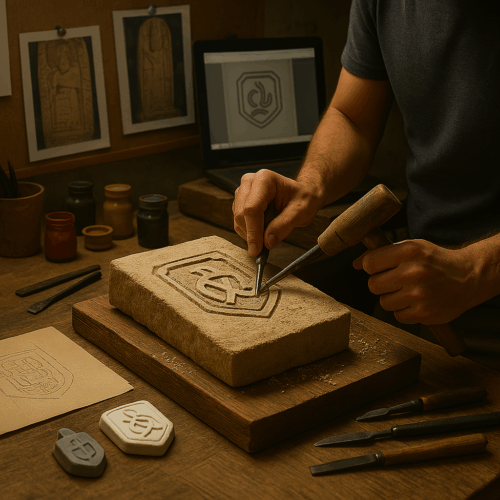 Conclusion: Carving Your Own Path in Modern Stone
Conclusion: Carving Your Own Path in Modern Stone
The enthronement of Siyaj Chan K’awiil I on July 8, 292 was more than a dynastic ceremony—it was an act of intentional story-making, binding ruler, people, and cosmos through stone and word. As we uncover the stela’s secrets, we learn that history’s power lies in deliberate inscription: choosing what to commemorate, designing symbols that endure, and renewing our narratives across generations.
Today, armed with digital tools and a global network, you have the means to craft your own lasting monuments. By adopting the Maya’s reverence for calendrical precision, communal storytelling, and ritual renewal, you transform fleeting achievements into enduring legacies. Let your personal stele stand as a beacon—testament to your vision, resilience, and the timeless human urge to leave a meaningful mark on the tapestry of time.

